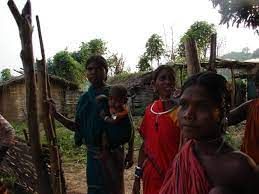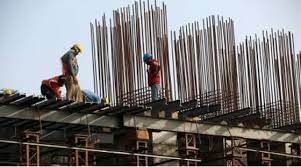UPSC Daily Current Affairs- 3rd February 2023 | Current Affairs & Hindu Analysis: Daily, Weekly & Monthly PDF Download
GS-II
India-USA relations
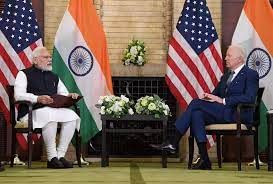
Context
The talks between India’s National Security Advisor Ajit Doval and his American counterpart Jake Sullivan have concluded with the announcement of a new road map for deeper military and techno-economic cooperation between the two countries.
- The bilateral Initiative on Critical and Emerging Technologies (iCET) could lend a new strategic depth and breadth to the expanding engagement between India and the United States.
- The idea was first mooted in the meeting between Prime Minister Narendra Modi and President Joe Biden on the margins of the Tokyo summit of the Quadrilateral Security Dialogue (Quad) in 2022
Bilateral relations
- The U.S.-India strategic partnership is founded on shared values including a commitment to democracy and upholding the rules-based international system.
- The United States and India have shared interests in promoting global security, stability, and economic prosperity through trade, investment, and connectivity.
- India and the United States cooperate closely at multilateral organizations, including the United Nations, G-20, Association of Southeast Asian Nations (ASEAN) Regional Forum, International Monetary Fund, World Bank, and World Trade Organization.
- India is an ASEAN dialogue partner, an Organization for Economic Cooperation and Development partner, and an observer to the Organization of American States.
- Together with Australia and Japan, the United States and India convene as the Quad to promote a free and open Indo-Pacific and provide tangible benefits to the region.
- India is also one of twelve countries partnering with the United States on the Indo-Pacific Economic Framework for Prosperity (IPEF) to make our economies more connected, resilient, clean, and fair.
- India is a member of the Indian Ocean Rim Association (IORA), at which the United States is a dialogue partner.
Political relations
- President Biden and Prime Minister Modi have participated in multiple engagements of the Quad Leaders mechanism with Japan and Australia
- The 2+2 Ministerial Dialogue between the U.S. Secretaries of State and Defense and their Indian counterparts is the premier recurring dialogue mechanism between the United States and India.
- The United States hosted the fourth 2+2 Dialogue in 2022.
- The United States welcomed India joining the UN Security Council in 2021 for a two-year term and supports a reformed UN Security Council that includes India as a permanent member.
- Various working groups – Civil Space Working Group, the Education and Skills Development Working Group, Trade Policy Forum, Defense Policy Group, and Counternarcotics Working Group.
Economic relations
- In 2021, overall U.S.-India bilateral trade in goods and services reached a record $157 billion.
- The United States is India’s largest trading partner and most important export market.
- Indian companies seek to increase their presence in U.S. markets and at the end of 2020, Indian investment in the United States totaled $12.7 billion, supporting over 70,000 American jobs.
- USA accounts for 16 percent in the exports of goods exports and 50 percent of IT and BPO services.
- Major items of exports to USA are apparels, diamonds, marine products and footwear – These industries are labour intensive and hence will pave the way for more employment opportunities in the sectors
Environment
- India and USA launched the “Climate Action and Finance Mobilization Dialogue (CAFMD)”.
- Under the Climate and Clean Energy Agenda 2030 partnership
- It was launched at the Leaders’ Summit on Climate in 2021
- In 2021, the United States joined the International Solar Alliance headquartered in India
- In 2022 the United States Agency for International Development (USAID) Administrator Samantha Power became Co-chair of the Governing Council of the Coalition for Disaster Resilient Infrastructure (CDRI) where India is a permanent co-chair.
- In 2021, The India-USA Strategic Clean Energy Partnership (SCEP) was launched in accordance with the US – India Climate and Clean Energy Agenda 2030 Partnership announced by both countries at the Leaders’ Summit on Climate
Technological
- The Indo-US Science and Technology Forum (IUSSTF) – is a bi-national autonomous organization established to promote cooperation in Science, Technology and Innovation has continued to play an important role in strengthening cooperation in this field.
- The iCET involves collaboration in a range of areas including quantum computing, semiconductors, 5G and 6G wireless infrastructure, and civilian space projects such as lunar exploration.
- It will be monitored and driven from the PMO in Delhi and the White House in Washington
- GE Aerospace has applied for an export licence for jet engine production and phased transfer of technology to Indian entities.
- ISRO and NASA are working together to realize a joint microwave remote sensing satellite for Earth observation, named NASA-ISRO Synthetic Aperture Radar (NISAR).
Defence and Security
- The Defense Policy Group (DPG) provides a platform for a comprehensive review of defense dialogues/mechanisms.
- The last DPG was held in 2021.
- The defense procurement activities are monitored through the Defense Production and Procurement Group (DPPG)
- In August 2022, a U.S. Navy Ship (USNS) Charles Drew visited in Chennai for repairs and allied services. This was the first ever repair of a U.S. Navy ship in India.
- US designating India as “Major Defence Partner,” a status unique to India, India is now at par with its closest allies.
- There is a new panorama for elevated Indo-US cooperation, like signing of Defence Technologies and Trade Initiative (DTTI), BECA, COMCASA, LEMOA etc
- The signing of Communication Compatibility and Security Agreement (COMCASA) – paved the way for supply of equipment with transfer of technology.
- The decision to start exchanges between US Naval Forces Central Command (NAVCENT) and Indian navy was another milestone for strengthening maritime cooperation in the Western Indian Ocean.
- Bilateral exercises include: Yudh Abhyas (Army); Vajra Prahar (Special Forces), a tri-services exercise– Tiger Triumph (inaugurated in 2019).
- India joined the multilateral Combined Maritime Force (CMF) based in Bahrain, as an Associate Partner in 2022.
- S. participated in India’s multilateral Exercise Milan 2022.
Indian Diaspora
- The 3.5-million-plus strong Indian American community is an important ethnic group in the U.S., accounting for about 1% of the total population in the country
- Almost 21% of total international students in the U.S. are Indians. In 2022 close to 82000 student visas were issued in India, mostly for graduate (Masters) programs
- The nearly 200,000 Indian students in the United States contribute $7.7 billion annually to the U.S. economy.
- With two Indian Americans occupying high level posts of Governor and several representatives of the people, the Indian Diaspora has assimilated into their adopted country and is acting as a catalyst to forge closer and stronger ties between India and the U.S.
- An MOU has been signed in June 2016 to facilitate India’s joining of the Global Entry Programme for expedited immigration for eligible Indian citizens at U.S. airport
Suggestion for future
- Enhance cooperation in emerging technologies and artificial intelligence (AI) as data regulation, information sharing, and privacy protection become increasingly salient issues crucial to the preservation of national security.
- Strengthen coordination multilaterally and on international issues, including prioritising two multilateral strategic dialogues that have gained prominence in recent years—i.e., the Quad and the West Asian Quad or I2U2.
- Pursue greater cooperation on counterterrorism, including coordinating strategies for managing a Taliban-led Afghanistan and leading multilateral efforts to apply pressure on the Pakistani military-intelligence complex to abandon support for terrorist groups such as the Taliban and Haqqani Network, and Kashmir-focused groups like Jaish-e-Mohammed and Lashkar-e-Taiba.
- Strengthen and integrate Global Value Chains(GVCs), using FDI in each other’s economies to strengthen bilateral trade and integrate GVCs as well as incentivise multinational corporations to participate in these initiatives.
- Seek greater coordination between line ministries working on cybersecurity, especially identifying relevant counterparts on specific issues.
- Embed security and defence issues into their emerging technology agenda, focusing for instance on identifying common principles for defence applications of artificial intelligence.
Way forward
- In recent years, exigencies such as the COVID-19 pandemic have redirected the relationship to a forward-looking assessment of regional and global geopolitics
- The sectors that will be key to shaping the arc of a strong Indo-US relationship in the years ahead are the following: emerging technologies; national security and defence cooperation; counterterrorism; and trade.
Source: Indian express
What is the Pradhan Mantri PVTG (Particularly Vulnerable Tribal Groups) Development Mission?
Context
Union Finance Minister recently announced a mission for the welfare of Particularly Vulnerable Tribal Groups (PVTGs) in the 2023-24 Union Budget.
About Pradhan Mantri PVTG Development Mission:
- The mission will be launched as part of ‘Reaching The Last Mile’, one of the seven Saptarishi priorities enlisted in this year’s Budget.
- The mission will saturate the particularly vulnerable tribal groups with safe housing, clean drinking water, education, nutrition, road and telecom connection and livelihood.
- A Budget of Rs 15,000 crore will be dedicated to this mission in the next three years.
- The scheme will benefit 3.5 lakh tribals.
Saptarishi priorities (seven priorities) enlisted in the 2023-24 budget:
- Inclusive Development
- Reaching the Last Mile
- Infrastructure and Investment
- Unleashing the Potential
- Green Growth
- Youth Power
- Financial Sector
Who are PVTG (Particularly Vulnerable Tribal Groups) ?
- PVTGs are more vulnerable among the tribal groups who are in need of greater support and development.
- Out of the 705 Scheduled Tribes in India, 75 have been identified as PVTGs and are spread across 17 states and one Union Territory.
- Government of India follows the following criteria for identification of PVTGs
- Pre-agricultural level of technology
- Low level of literacy
- Economic backwardness
- A declining or stagnant population.
- In 1975, the Government of India initiated to identify the most vulnerable tribal groups as a separate category called PVTGs and declared 52 such groups.
- An additional 23 groups were added to the category in 1993.
- Some Examples: Cholanaikayan (Kerala), Kathodi (Gujarat), Jarawas (Andaman & Nicobar Islands), Koraga (Karnataka)
Source: The Hindu
Deep Ocean Mission
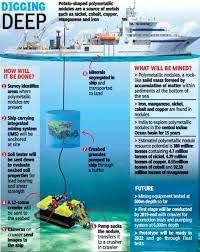
Context
In the Union Budget 2023-24, Deep Ocean Mission has been allocated Rs 600 crore
Deep Ocean Mission:
- It aims to explore marine biodiversity for the sustainable use of resources
- It is overseen by the Ministry of Earth Sciences (MoES)
- It includes myriad of activities such as a manned submersible, ship-building, exploration and conservation of deep-sea biodiversity and identification of mineral deposits in the deep ocean
- A manned submersible will be developed to carry three people to a depth of 6,000 metres in the ocean
- In 2016, India was awarded a 15-year contract to explore an area of 75,000 square kilometres for mining polymetallic nodules from the Central Indian Ocean Basin at depths of 5,000-6,000 metres.
- The other components of the mission include developing ocean climate change advisory services and designing offshore Ocean Thermal Energy Conversion (OTEC) powered desalination plants.
Significance
- Oceans are storehouses of food, energy, minerals, and medicines.
- It also modulates weather and climate.
- Deep-sea mining involves extracting ores rich in cobalt, manganese, zinc and other rare metals from the sea floor.
- They contain critical minerals needed to build batteries for electric vehicles and renewable energy capacity, smartphones and laptops.
Source: DTE
GS-III
What is Urban Infrastructure Development Fund (UIDF)?
Context
Finance Minister recently announced that government will set up an Urban Infrastructure Development Fund (UIDF) of Rs 10,000 crore per year for creating infrastructure in Tier-2 and Tier-3 cities.
About Urban Infrastructure Development Fund (UIDF):
- UIDF will be established through the use of priority sector lending shortfall.
- Purpose: The fund will be used by public agencies to create urban infrastructure in tier-2 and tier-3 cities.
- It will be managed by the National Housing Bank.
- It will be established on the lines of the Rural Infrastructure Development Fund (RIDF).
- States will be encouraged to leverage resources from the grants of the 15th Finance Commission, as well as existing schemes, to adopt appropriate user charges while accessing the UIDF.
What are tier-2 and tier-3 cities?
- Cities with a population in the range of 50,000 to 100,000 are classified as tier 2 cities, while those with a population of 20,000 to 50,000 are classified as tier 3 cities.
What is Rural Infrastructure Development Fund (RIDF)?
- The RIDF was set up by the Government in 1995-96 for financing ongoing rural Infrastructure projects.
- The Fund is maintained by the National Bank for Agriculture and Rural Development (NABARD).
- Contribution: Domestic commercial banks contribute to the Fund to the extent of their shortfall in stipulated priority sector lending to agriculture.
- Main Objective: To provide loans to State Governments and State-owned corporations to enable them to complete ongoing rural infrastructure projects.
- Repayment period: Loan to be repaid in equal annual instalments within seven years from the date of withdrawal, including a grace period of two years.
Source: The Hindu
Bar-headed goose

Context
A bar-headed goose, which was tagged in Mongolia in July 2014 has recently been spotted in Koonthankulam - Kadankulam Bird Sanctuary in Tirunelveli district, Tamil Nadu.
About Bar-headed goose:
- They are large pale grey birds which are considered one the world’s highest flying birds.
- They are known for their migration spanning distances of over 1,600 km in a day. They are also known for reaching extreme altitudes of 29,500 feet during their twice-yearly migrations across the Himalayas.
- Scientific name: Anser indicus
- Distribution: Native to central Asia, where the species breeds, they are found in India, Pakistan, Nepal, Kazakhstan, Bangladesh, Myanmar, Japan and other nearby regions.
- Habitat: They breed around lakes and marshes on highland plateaus; winters in lowland wetlands and fields.
- Features:
- This species is gray and white with two horseshoe-shaped, brownish-black bars on the back of its white head.
- The bill and legs are pink, orange, or yellow.
- IUCN Status: ‘Least Concern’
Source: Indian Express
Asiatic Black Bear
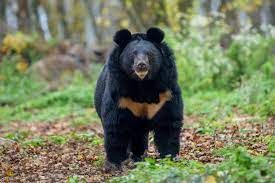
Context
The Kashmir Valley has bucked the trend of Asiatic black bear attacks on humans rarely reported throughout the animal’s global range.
Asiatic Black Bear
- Scientific name – Ursus thibetanus
- It is also called Himalayan bear, Tibetan bear, or moon bear
- It has a glossy black (sometimes brownish) coat with a whitish mark shaped like a crescent moon on the chest.
- Its long, coarse neck and shoulder hair forms a modified mane.
- It is omnivorous, eating insects, fruit, nuts, bees and honey, small mammals, and birds as well as carrion.
- It occasionally attacks domestic animals.
- They are generally nocturnal, sleeping in caves or tree hollows during the day
- During the summer the Asiatic black bear lives mainly in forested hills and mountains at elevations up to 3,600 metres (11,800 feet).
- Becoming fat by fall, it spends the winter at elevations of 1,500 metres (5,000 feet) or less and may sleep for much of the time.
- An adult male weighs 100–200 kg (220–440 pounds), a female about half as much; its length averages about 130–190 cm (51–75 inches), in addition to a 7–10-cm (3–4-inch) tail.
- Asiatic black bears may live as long as 25 years in the wild and up to 39 years in captivity.
- IUCN status – Vulnerable
- All Indian Bear species are listed under Appendix I in CITES and Schedule I of the Wildlife (Protection) Act, 1972.
- This provides complete protection to the species from hunting and trade.
Distribution
- Afghanistan; Bangladesh; Bhutan; Cambodia; China; India; Iran, Islamic Republic of; Japan; Korea, Democratic People’s Republic of; Korea, Republic of; Lao People’s Democratic Republic; Myanmar; Nepal; Pakistan; Russian Federation; Taiwan, Province of China; Thailand; Viet Nam
Reproduction
- Males and females become sexually mature between ages three and four.
- Mating occurs between June and October, and pregnancies typically produce two cubs some seven to eight months later.
Source: The hindu
Reverse-flipping
Context
Economic Survey 2022-23 has suggested measures like simplifying ESOP taxation, and easier corporate laws like in the US and Singapore to accelerate reverse-flipping among startups, namely moving domicile back to India.
About Flipping and Reverse-flipping:
- Flipping is the process of transferring entire ownership of an Indian company to an overseas entity.
- It is generally accompanied by a transfer of all intellectual property and data owned by an Indian company.
- Reverse Flipping is the process of shifting the domicile of those companies back to India who flipped earlier.
- Companies reverse flip because of easy access to capital from private equity and venture capital, changes in rules regarding round-tripping, and the growing maturity of India’s capital market.
Reasons for Flipping:
- Flipping happens at the early stage of the startups, driven by commercial, taxation and personal preferences of founders and investors.
- Some companies decide to ‘flip’ because the major market of their product is offshore.
- Sometimes, investor preferences like access to incubators drive the companies to ‘flip’ as they insist on a particular domicile.
- For easy access to capital from private equity and venture capital, changes in rules regarding round-tripping, and the growing maturity of India’s capital market.
Source: The Hindu
|
38 videos|5269 docs|1114 tests
|
FAQs on UPSC Daily Current Affairs- 3rd February 2023 - Current Affairs & Hindu Analysis: Daily, Weekly & Monthly
| 1. What is the significance of GS-II in UPSC exams? |  |
| 2. What are the key topics covered in GS-II? |  |
| 3. How can one prepare for GS-II effectively? |  |
| 4. Are there any specific resources or books recommended for GS-II preparation? |  |
| 5. How much weightage does GS-II carry in the UPSC exams? |  |

